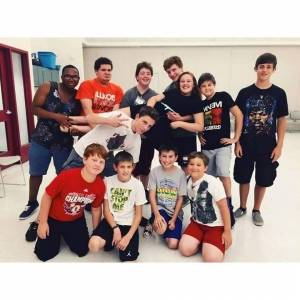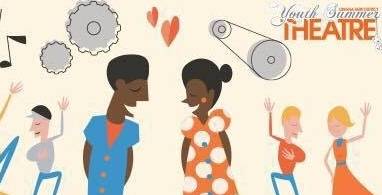The Urbana Park District will be performing The Pajama Game in late July. The show is set to feature young performers from the age of 8 to 18 acting and singing. To get a preview of the show we interviewed Kyle Thomas, the director, and Justin Brauer, the Music Director.
The director describes The Pajama Game as set in a factory that makes pajamas in the mid-1950s and tells the story of the factory workers’ union working to convince the company’s president to provide them with a much-needed and well-deserved 7 1/2 cent raise. As this story unfolds it also follows the growing affections between one of the factory workers and union leaders, Babe Williams, and the factory supervisor, Sid Sorokin.
SP: Why did you choose this particular musical/performance for your presentation for the park district?
Kyle Thomas: One of the things that I stress whenever I work with the UPD Youth Summer Theatre is the importance of the collaborative and inclusive process that is at the heart of theatre. So, I was looking for shows that really brought this approach to life.
SP: Were there any other shows you were thinking of using?
Thomas: As a part of the process of selecting a show, I did consider some other musicals, but ultimately settled on The Pajama Game because I felt that I would be able to give all the cast members an important role to play in telling this fun story.
SP: For people who have never heard of The Pajama Game, how would you describe it to get them interested or excited?
Justin Brauer: Much of the show takes place inside the pajama factory, and traditionally this means lots of big machinery on the set. In our production, we’ve chosen to use a minimal set, and the cast is on stage moving a lot, and have taken the role of all those moving parts that would be in a real factory. This is really cool visually, but it also means that our students get more stage time than they might normally That’s been a good learning experience for them, I think, since they not only have to be responsible for their own movement but they also have to be aware of what everyone else on stage is doing.
Thomas: […] There are multiple reasons why I like this story and find it topical and important for today’s audiences. Firstly, it gives a glimpse into the now lost world of American manufacturing and the important role that unions played in protecting the average worker. Conversations about compensation and the role of labor unions are still a major part of the American workplace today. But perhaps the thing that I like the most in this show is its treatment of women. Musicals in the 1950s (and even still today) often treated women simply as the objects or trophies of the major male characters. The plot of most shows is centered on the exploits of some guy as he tries to win the love of his female counterpart. Sid and Babe fall in love very quickly, and often it’s Babe that dictates the parameters of their relationship. They are equals in this show. It’s a very modern show for having been written in the 1950s.
SP: What is unique about this particular program?
Brauer: Our aesthetic inspiration for the show is an old cartoon from the 50s based on a Dr. Seuss story, Gerald McBoing Boing. This has carried into the poster design, the set, lighting, and projection design, and even the choices I’ve made in reducing the orchestration. It’s a very stylized mid-century modern look and feel, which I think lightens the mood of the production and brings it out of that heavy realism that sometimes comes with prductions of musicals from this period.
As far as this being a “kids production,” audiences will be surprised at the amount of work that our students are putting in. Even the students were surpised, I think, the first couple weeks of rehearsal at the level at which we’re running rehearsals. The entire production team comes from professional performance backgrounds, and we’re bringing that attitude into the rehearsal studio. The hope is that our students get to experience more than just two months of hanging out with their friends at night, and that they create an excellent product that they’re really proud of.
SP: How have rehearsals been going for this show? Everything going smoothly or have there been hiccups?
 Thomas: Rehearsals have been going well. It’s always a little difficult to accommodate over 50 schedules during the summer, but I feel that our production team has done an excellent job at teaching the material and getting the show on its feet. Our cast members have also been fantastic at working on their material at home and coming to rehearsals prepared. I’m very proud of this cast and I think they’re going to give our audiences a great show.
Thomas: Rehearsals have been going well. It’s always a little difficult to accommodate over 50 schedules during the summer, but I feel that our production team has done an excellent job at teaching the material and getting the show on its feet. Our cast members have also been fantastic at working on their material at home and coming to rehearsals prepared. I’m very proud of this cast and I think they’re going to give our audiences a great show.
SP: Does the Park District put on many of these kinds of shows? How do you guys get the word out for these types of things to get people interested in going?
Thomas: The Urbana Park District has had a youth summer theatre program for many years. This is only the second year that I have directed a show for them (I directed The Music Man in 2013), but I very much feel apart of the UPD YST family. We will be doing several appearances on local television and radio programs so look out for those in July! You’ll also see our posters around Urbana and Champaign and I must thank all our volunteers, both parents and cast members, for helping us spread the word.
SP: What is it like working with such a huge cast of students for this performance?
Brauer: I love working with large casts like this — it’s definitely difficult at times, because if we’re working with soloists or featured performers during a portion of a full cast rehearsal, the students who aren’t being worked with for those five minutes start to get antsy. But with such a large cast and age range, the older students tend to step up and assume leadership roles within the cast, and serve as role models for the younger students.
SP: Is it a lot of work to get everything coordinated and make sure you get enough attention to each performer?
Brauer: Coordinating the schedule is Kyle’s (Kyle A. Thomas, our director) domain- he does a really great job setting the schedule before rehearsals start so that our students and their parents know exactly when they’ll be called for rehearsal, and that their time will be used well while they’re here. He, Maggie (Kinnamon, our choreographer, whose three kids are also in the show,) and I met a couple of weeks before reheasals began to discuss how much time we would need for each component of the show, and then he structured the schedule around that.
SP: What’s it like working with live musicians along with the performers and making sure everything is in sync? Is it a lot of difficult work or does everything sync well with a enough working?
Brauer: Coordinating the orchestra and the singers can be a daunting task, especially with the limited rehearsal time I get with the orchestra before they join the cast. I always open up cast rehearsals for the orchestra to come and play to get extra practice before we get into the theatre, which helps both the cast and the orchestra get comfortable with each other. I conduct from the piano, so part of it is hiring musicians who I trust and know will be responsible for their music and will be able to follow the head nods and eyebrow lifts that I can give while playing and also cueing the singers. I’ve been working with Justin Peters (a fantastic percussionist) for four years now, so he’s always my first call because I know that he and I speak the same language when we’re playing together.
The Park District also has partnered with the Urbana Pops Orchestra for a number of years, and they hire the majority of the musicians. Daniel Southerland, John Gorecki, and I have been in communication for a couple months now figuring out how many players we need, as well as coordinating the pieces we’re doing for the Urbana Pops concert on July 11th, where we’ll be performing five numbers. John has done some great jazz band arrangements of those numbers for that concert.
SP: Anything else you’d like to add or explain?
Thomas: Putting on a musical with over 50 young theatre artists under the age of 18 is never an easy task. I don’t mean to make it sound like my job is difficult, but to state that these things do not just come together on their own. It takes a lot of work by a lot of people to see these things make it successfully to the stage and, most importantly, it takes the drive and desire of the kids involved in reaching a level of excellence to carry the show throughout its run and provide our audiences with an enjoyable experience. It is always a joy to see these young people take up a daunting task and succeed with flying colors. So, if you want to have a great evening and see several young people do something amazing then please make plans to attend The Pajama Game.
Brauer: Audience members who are familiar with the film will find some changes in the stage production- there are a few additional songs, and we’ve updated some lyrics and staging to make the show more appropriate for our cast. It was written in the late 50s, and there’s some material that just doesn’t fly in 2015. The cast has been really great about adapting those parts. Last night we spent a half hour rewriting some blocking and music in the second act with the help of some of the men in the cast. The cast has started really taking responsibility for their own performances, and we’re seeing actors make choices on their own, which is fantastic.
Performances of The Pajama Game are July 22-25 at 7 p.m. in the Harold and Jean Miner Theater at Parkland College. Ticket prices are $14 for adults, $10 for students and seniors, and $7 for children 12 and under. You can pre-purchase tickets online or by calling 217-367-1544, or hope the shows are not sold out and take your chances at the door.
Images from the production’s Facebook page.








